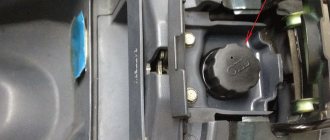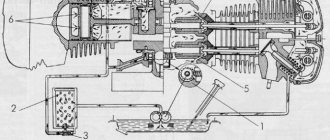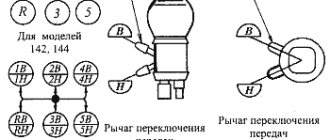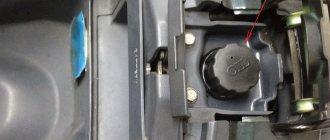Front fork
I was thinking about changing the oil in the front fork on an Alfa, I looked on the Internet and found how much to pour (in the Alfa 120 ml, in the Delta 160 ml (in each leg)), but I couldn’t find any exact criteria about what kind of oil to pour there.
Questions: Have you changed the oil in the fork? Which one did you fill and how many ml? At what mileage did you decide to change the oil?
Added after 5 minutes
I’m also thinking about replacing the front drum brake with a disc brake, but since there is no mount for a caliper on the fork legs, I’m thinking of installing a complete fork or just the legs from Parton King 50. But I don’t know the size of the fork from King and whether it will fit into the Alpha yokes
There, as far as I know, the oil is not changed but topped up as needed. They suggested oil to me and 20. spindle in common parlance.
Added after 2 minutes
I’m also thinking about replacing the front drum brake with a disc brake, but since there is no fastening for a caliper on the fork legs, I’m thinking of installing a complete fork or just the legs from Parton King 50. But I don’t know the size of the King fork and whether it will fit into the Alpha crossbars [/ quote]
Take and measure the diameters of the pipes with a rod of both. And compare. But there is no reason to install a disk drive on 50 cubic meters. And then decide for yourself.
I changed it and barely opened the feathers. Clamped in a vice in a barbaric manner, removed the decor on the fork and clamped it in it. So I opened it. I temporarily filled it with 10w40, at least better than the original oil. I poured it to the edge in clamped fork. (This might be correct, but it’s temporary)
They also pour a transmission (a wide variety), there is a special one. oils for this, for example Motul fork oil expert of different hardness 7.5W 10W 15W. (Light, medium, hard)
Hydraulic oil MGP-10 TU U 00152365.111-99
Hydraulic oil MGP-10 is a composition of low-viscosity, low-solidifying petroleum oil, depressant, dispersant, anti-wear, antioxidant and anti-foam additives.
Intended for use as a working fluid in hydraulic shock absorbers of automobiles
Ensures shock absorbers operate over a wide temperature range.
Good anti-wear characteristics. Physico-chemical indicators: No. Name of indicator Indicator value 1. Color, CNT units, no more than 5 2. Kinematic viscosity, mm2/s at minus 20°C, no more than 1000 at plus 20°C, not less than 35, 0 at plus 50°С, not lower than 10 3. Pour point, °С, not higher than minus 40 4. Flash point, determined in an open crucible, °С, not lower than 145 5. Acid number, mg KOH/g oil, not more than 0.15 6. Corrosion effect on metal withstands 7. Mass fraction of water, %, no more than none 8. Mass fraction of mechanical impurities, %, no more than none 9. Change in rubber volume after aging, %, ranging from minus 6 to plus 6 10. Tribological characteristics on a four-wheel drive: welding load (Рз), N, not less than 2820 critical load (Рк), N, not less than 710 scuffing index (Iz), N, not less than 324 Added after 6 minutes
To watch online, click on the video ⤵
Changing the oil in the fork of an Alpha/Delta moped. Manual.TO. More details
Alfa moped fork repair. Replacing seals in the fork. More details
Changing the oil in the fork of Alpha and Delta mopeds Read more
Changing the oil in a moped fork | Replacing fork seals on a moped | The fork on the moped is leaking Read more
Moped "Alpha". How to pick fork feathers with your own hands. More details
Motorcycle routine #2.Changing the oil in the front fork on an Alpha moped. More details
A little advice: how much oil to pour into the fork of an alpha, delta moped. More details
Changing the oil in the moped fork Replacing the fork seals More details
Front fork. How much oil to fill!? More details
Disassembly of moped fork (delta, alpha) More details
#97 Replacing alpha moped fork seals (part 1 - disassembly) More details
Alpha engine repair (Delta, Sabur, Cub) More details
Replacing Fork Seals on a Motorcycle Read more
How to Change Fork Seals on a Motorcycle Read more
about speed limiters Alpha, delta. More details
Moped Alpha Replacement of steering column bearings and tachometer glass More details
how to install another fork on an alpha moped Read more
How to pour oil into feathers without pulling them out? moped Delta, Atlant, Orion More details
How to disassemble the fork on an alpha moped. How much oil to pour into the fork on an alpha moped. More details
Video review of the Alpha 72cc moped
The Alfa moped has its own body kit, front and rear shock absorbers, a 4-stroke engine, in general the characteristics are impressive, they will be discussed in more detail below.
The technical characteristics of Alpha mopeds are impressive and constitute serious competition in the market for companies selling mopeds. Perhaps we should start with the engine.
The engine has 4 strokes, like a passenger car, and is air cooled. The engine capacity is 72 cubic centimeters, but with such small volumes it develops quite a lot of power.
There is a possibility of tuning up to the Alpha 110cc moped.
The engine is powered by an electric starter, but if it malfunctions (this happens very rarely on a moped), you can use a kick starter, that is, start the moped manually. We started it up and now we can safely drive, a four-speed manual transmission will set us in motion.
There is a chain running from the engine to the wheel, not a driveshaft. The moped is one meter long, one meter high and half a meter wide. Its own weight (without any bells and whistles) is eighty-one kilograms. Quite light weight for such a moped. The front wheel is seventeen inches, the rear is the same, but the rear has more volume than the front. The brakes are activated by pressing the levers on the steering wheel. The brakes are of a drum design.
What kind of oil to pour into the fork of an Alpha moped
How to change engine oil in a motorcycle?
This procedure, like changing the oil in a forklift motorcycle, scares not only beginners, but also experienced drivers. Even professional mechanics often spend a lot of time doing this job because they have to deal with so many details. In addition, you need to choose the right oil that will allow you to achieve the required suspension stiffness parameters. Therefore, it is necessary to approach this procedure only after careful preliminary preparation.
Oil change frequency
Most manufacturers recommend changing the oil in the front suspension of a motorcycle every 12-15 thousand kilometers to ensure good handling of two-wheelers. However, experienced owners prefer to simultaneously replace planned repairs, that is, install new cuffs. This allows you to get the optimal fork without having to go through a long, lengthy setup.
It is recommended to change the oil after idling the engine in winter, as it may partially or completely lose its properties at low temperatures. If the motorcycle is used for sports and the requirements for its disposal are very high, the frequency of replacing technical fluid should be reduced to 5 thousand kilometers. Experienced drivers recommend changing the fluid when the plug wears out. This is reflected in deep “beaks” when braking, as well as destabilization of the motorcycle at high speed. In this situation, it is recommended to buy high viscosity oil to stiffen the suspension and also improve the handling of the two-wheelers.
Oil selection
It is very difficult to choose fork oil, despite the recommendations of automakers. The problem is that motorcycle manufacturers often specify ideal viscosity parameters at operating oil temperatures that are many times higher than those at which the hydraulic fluid is poured into the plug. Therefore, it is necessary to pay attention not only to the standard designation of viscosity, but also to its coefficient of change with increasing temperature. Such information is often listed on the liquid container, and in the absence of such information, you will need to look at the manufacturer's website or special materials published by technical experts.
Since the characteristics of oils from different manufacturers with the same SAE designation can differ significantly, it is better to choose one brand and keep up with the times. The first change is always made with oil of the same viscosity as specified in the vehicle's operating instructions. If the tube stiffness decreases significantly, the viscosity will need to be gradually increased. 2.5W or 5W for each subsequent replacement, depending on your personal preference. Most touring motorcycles recommend 10 watts of oil, as well as sport and high-performance city bikes. 2.5-5 W
How often should you change the oil in your moped?
In the operating instructions, the first oil change (on a new moped) is after 500 kilometers (TO-1). The second replacement is at 1500 km (TO-2). The third replacement is at 3000 km. (TO-3). Then every 2000 km. But there is an indication that if the moped is operated under increased loads and in dusty conditions, the oil needs to be changed (maintenance) more often.
Personally, I change the oil every 1500 km.
How much oil to pour into an Alpha engine?
The owner's manual says to fill the crankcase with 0.9 liters of four-stroke engine oil. In practice, it may turn out that not all of the old oil has left the engine. I usually do this: fill in 0.8-0.85 liters of oil, control its level with a dipstick and top up if necessary.
Where to fill oil in Alpha mopeds?
When faced with servicing a moped for the first time, many owners look for a separate oil filler neck on the engine. But in fact, the engine developers acted very wisely: oil is poured into the engine through the hole with the dipstick. It is located on the right side of the engine. To avoid spilling oil on the engine, I usually use a small plastic funnel bought at a hardware store; it makes filling quick and clean.
How to choose oil for a moped?
To choose the right oil for a moped, consulting a salesperson in a store is not enough. Moreover, many of them have only superficial knowledge of the characteristics and properties of motor oils.
Motor oils should be selected depending on the engine installed on the motorcycle.
It should be remembered that in the regulatory and technical literature there is no special term “scooter oil”. However, in the store you often find oils specifically designed for motorcycle and moped engines. You can purchase them with confidence, paying attention only to what type of engine they are suitable for: two-stroke or four-stroke.
Can I put car oil into an Alpha Delta moped?
If you want to make money on YouTube, then click here Help with the development of mine.
Next letter. oil generation symbol. The designation is in alphabetical order, that is, the further the letter is from the beginning of the Latin alphabet. that oil generation is higher (performance is better).
Currently, API categories API SA, SB, SC, SD, SE, SF, SG are considered invalid, category SH is considered conditionally valid. Therefore it is recommended in the instructions for moped categories SE
also
can’t find SF Then what oil should you buy? The answer is to buy any, following in alphabetical order (SJ, SL, SM, SN), it will in any case be no worse than the recommended one.
engine's type
When buying oil for a motorcycle, you need to pay attention to its classification, as well as the content of special additives.
To choose which oil to put into your scooter, first consider the engine type: products for two-stroke engines are not suitable for four-stroke engines, and vice versa. The fundamental difference in operation: oil for two-stroke engines is mixed with gasoline in a ratio of 1:25 or 1:50, depending on the manufacturer’s recommendation. Lubricant replacement in four-stroke engines occurs by draining the old product from the oil tank, washing and filling with a new one.
The choice between mineral, semi-synthetic or synthetic oil for mopeds and scooters is not difficult. For economy class mopeds and scooters, mineral or semi-synthetic is perfect. Mineral varieties are the cheapest, so they are more often purchased by poor scooter owners. But when using them, you should remember that they are chemically unstable, so the timing of their replacement must be strictly observed. Semi-synthetics are preferable to mineral ones, but are noticeably more expensive. Synthetic oil is intended for high-speed boosted scooters, whose engines place increased demands on oil quality. It preserves engine life better, has better viscosity, lower volatility, and a wider range of operating temperatures. For inexpensive mopeds, synthetics are just an unnecessary luxury.
Gearbox oil
The instructions say what kind of oil should be poured into the engine, but there is not a word about the gearbox. Although we are all accustomed to the fact that transmission oil is poured into the box, usually thicker than in the engine.
Owners of Alpha mopeds (and the like) need to know that the gearbox, engine and clutch are located in the same (common) crankcase and are lubricated with the same oil . This way you don’t have to think about what kind of oil needs to be poured and where. It is one!
Marking and viscosity
SAE recommended viscosity table.
Engine wear is affected by the oil viscosity parameter . The required viscosity depends on the operating temperature of the engine and is usually specified in the operating instructions. The generally accepted standard for designating viscosity according to the American SAE method: 5W40, 5W30, 10W40, 10W50 or simply SAE 40, SAE 50. Moreover, the first number indicates the viscosity of the oil in a cold engine, the second - in one warmed up to operating temperature. The letter W indicates that the oil belongs to winter or all-season varieties. Summer varieties do not have this letter and the first number (SAE 30, SAE 40). The lower the first number, the better the engine starts in cold weather. But if there is no need to ride a moped in winter, there is no point in using liquid oil. In warm weather, high viscosity provides better lubrication of power unit parts, the oil film on rubbing surfaces is not destroyed, and dry friction, overheating and destruction of parts are prevented.
For summer, viscosity 10W40, 10W50, SAE 30, SAE 40, etc. is more suitable. The higher the viscosity of the oil when hot (second number), the better suited the oil is for hot operating conditions. In mid-latitudes, SAE 30 or SAE 40 is quite suitable. In hot countries, SAE 50 and even SAE 60 are used.
SAE classification
The latest edition of the classification divides motor oils into 11 classes: 6 winter (0W, 5W, 10W, 15W, 20W, 25W) and 5 summer (20, 30, 40, 50, 60) viscosity classes. The letter W (Winter) before the number means that the oil is adapted to work at low temperatures.
Most motor oils on the market today are all-season, that is, they meet viscosity requirements at both low and high temperatures and have a double designation, for example in our case: SAE 15W-40 . The first number characterizes the pumpability of the oil at low temperatures. If you subtract 35 from the first digit, you get the minimum temperature at which a safe cold start of the engine is possible. The second number is an indicator of oil viscosity at 100 degrees Celsius. If you add 5 to the second digit, you get the maximum permissible air temperature at which the oil can be used.
It will be useful: Replacing the rear brake pads of a Kia Sportage 1
Quality Standards
Motor oils have various specifications indicating their quality: API, JACO and others.
The oil standard is indicated on the canister. After the letters API there is a letter designation of oil quality: from SA to SM. The S scale indicates that the oil belongs to gasoline engines; the quality scale is indicated by letters from A (low quality) to M (high quality). A total of 11 quality classes are provided: A, B, C, D, E, F, G, H, J, L and M. Products with specifications from SA to SE are currently almost never produced and are only suitable for older equipment manufactured in 80s or 90s. Modern mopeds and scooters consume oil of at least SF quality, but it is better if it is SH, SJ or SL.
Scheme for studying the motor oil label.
SH - products for engines manufactured after 1994. SJ - for engines manufactured after 1996. SL – for engines after 2000. SM – for engines after 2006.
API-TA is required for two-stroke moped and lawn mower engines. For large capacity two-stroke engines of low power - API-TB standard. For powerful large-capacity two-stroke engines - the API-TC standard.
The Japanese JASO standard is intended for models of mopeds and motorcycles with a “wet” clutch, that is, a clutch operating in an oil bath. With this design, the power unit and clutch use the same oil. Accordingly, changing the transmission oil on the scooter will occur simultaneously with replacing the engine oil. Therefore, using a high quality, low friction product may cause this clutch to slip. JASO is suitable for motorcycles manufactured before 1994 or copied models of that time. For modern mopeds and scooters, you should choose JASO MA, JASO MA-1 with a high friction coefficient. The JASO MA-2 standard has an even higher coefficient of friction, but is intended for sports mopeds and scooters. JASO MB has a low coefficient of friction and is not suitable for wet clutch vehicles.
For two-stroke engines, the JASO standard has completely different designations. JASO FA - intended for use in developing countries. JASO FB is the minimum quality standard for Japan. JASO FC is a smokeless oil for a wide range of two-stroke engines made in Japan. JASO FD – for two-stroke engines with increased requirements for the quality of motor oils.
The European ACEA oil quality designation standard is often found. Grades ACEA A1 to ACEA A5 are intended for four-stroke gasoline engines (two-stroke engines are not produced in Europe). Moreover, category A2 denotes the lowest quality oil, and A4 - the highest quality. For engines with normal operating characteristics, category A2 is recommended. Category A3 is recommended for use in motors with high performance. Category A4 is used in motorsports. Certain categories A1 (with particularly low viscosity) and A5 (the latest oils) are not suitable for all engines and are used only in cases where this is directly specified by the manufacturer.
Manufacturer
The question of choosing a brand is more individual. If your financial capabilities allow, you can buy expensive branded oil. Only for inexpensive scooters, choosing an expensive oil does not lead to any improvements in performance. Maximum – will increase the life of the piston group by 5-10%. Typically, oil changes are carried out every 1000-2000 km. An expensive product does not have time to exhaust its service life within this period and it is necessary to discard the still high-quality product. And untimely oil changes, not prescribed by the manufacturer, are not recommended: over time, the oil accumulates foreign impurities and, instead of protecting against wear, begins to contribute to even greater wear of the rubbing surfaces. As a result, using expensive oil in a regular moped is an unjustified waste of money.
Oils from the MOTUL, LIQUI MOLY and IPONE brands have the highest performance characteristics and are perfect for powerful sports and racing engines, but the price for these products is quite respectable. The British brand CASTROL is also famous for its high quality, but is more affordable. Also in the middle price range can be considered products from MANNOL, VALVOLINE and RAVENOL. The Korean brand ZIC is the cheapest of the imported ones. Provides good performance properties subject to timely oil changes. The domestic budget option is LUKOIL, well suited for both urban and rural use.
Synthetic, semi-synthetic or mineral water?
It is generally accepted that synthetic oils are of the highest quality and almost extend the life of the engine. On the other hand, as I wrote above, now any oil that has been certified in accordance with the API standard is suitable for use in the Alpha moped engine.
I have chosen a golden mean for myself: I introduce semi-synthetic imported manufacturers into the moped; The price of a liter of semi-synthetic oil is not much different from the price of petroleum products.
But only now it is rarely found on the shelves of semi-synthetic 15W-40. Mostly mineral oils are sold under this designation. Therefore, I fill the engine with 10W-40 oil as closest to the manufacturer's recommendations.
Features of changing oil in a motorcycle fork
The main reason for changing the oil in a motorcycle fork is its leakage; it can be associated with various reasons. A scheduled oil change in this unit is provided for, but due to the lack of significant production, it is not carried out often.
There can only be two reasons for oil loss in the front suspension. When this happens, it becomes necessary to disassemble the entire assembly, and this is not at all difficult to do, but putting the plug back together is somewhat more difficult. To do this, you need to carefully read the instructions for repairing a motorcycle; this article will provide the main approaches to replacing the lubricant, a step-by-step plan for all operations and a list of tools that will be needed during the repair.
Main causes of leakage
There are only two reasons why oil may leak from a motorcycle fork:
- Rough operation - leakage in the motorcycle fork can occur when driving carelessly, when the driver ignores potholes and potholes on the roads or the driving style borders on extreme;
- Long-term downtime - in this case, the seals located in the inner part of the suspension dry out and become smaller.
Main mistakes
Illiteracy during this procedure can be very expensive, because not adding a small amount of oil to the fork of a Honda motorcycle can lead to it not fully performing its functions and this will pose a threat to the health or even life of the driver.
Most often, such an error occurs due to the inexperience of the mechanic, because the calculation of the required amount of oil was made incorrectly. Or because the mechanic overestimated the amount of oil remaining inside the fork. In this case, it will not be possible to adjust the suspension, and riding such a motorcycle is risky.
Important to remember! The main indicator that you should rely on when calculating the required amount of oil in the fork is the distance from the level of the filled lubricant to the upper surface of the cup in a compressed state.
The second common mistake is changing oil of the wrong viscosity that is intended for these purposes; this can be based on:
- Lack of technical fluid of the required kinetic viscosity at the time of replacement;
- Lack of a service manual, or misunderstanding of the instructions.
The second reason is often committed through inattention, and the first through ignorance.
Frequency of planned replacements
The oil for a motorcycle fork is changed according to its service life after approximately 10-15 thousand kilometers; this figure largely depends on the manufacturer and its recommendations. If the replacement is not made on time, the motorcycle may lose control and the suspension will behave unpredictably.
It would be ideal to combine a scheduled oil change with a major suspension overhaul; in this case, it will be easier to replace the old seals. After a major overhaul and renewal of the seals, the fork stiffness will increase, and its adjustment can be made much less frequently.
Most often, the oil loses some of its qualities after a long winter period of inactivity, in which case it is recommended to change it as well.
The loads placed on the suspension of a motorcycle participating in sports competitions reduce the service life of the oil. In some cases, it can be reduced by three times.
Although most motorcyclists decide to change the oil only after noticeable wear of the fork. It manifests itself in dives during braking and in disruption of the bike's stability at high speeds.
Advice! In order to mitigate these problems, the oil should be replaced with one that has high kinetic viscosity.
Selecting technical fluid for the front suspension
The abundance of lubricants on the market makes it difficult to decide which oil to pour into a specific motorcycle model. Another difficulty lies in the fact that you cannot always trust the recommendations of motorcycle manufacturers.
An error may arise from the difference in oil performance in cold and operating conditions. When choosing, you should take into account both standard kinetic viscosity indicators and the coefficient of their change at elevated temperatures.
Advice! If the coefficient of change in viscosity is not indicated on the container, then you should go to the manufacturer’s website and find out what it is, otherwise there is a high probability of an erroneous purchase.
Experienced mechanics recommend not changing a lubricant from one manufacturer to another with similar specified characteristics, since tests are carried out on different equipment and the same parameters on paper can differ greatly in reality.
Important! During the first change, the oil should have the same viscosity as what was filled at the manufacturer’s factory and specified in the operating instructions. If the stiffness of the fork is lost over time, then gradually switch to lubricants with a higher viscosity.
The viscosity of the oil being poured also depends on the type of motorcycle, so for sports bikes it should not exceed 5W, and for mountain bikes oils with a viscosity of about 10W are poured.
Work order
First you need to decide what you will need; to change the oil in your motorcycle you will need the following tools:
- A set of wrenches - they must be strong enough, because sometimes it is not easy to tear off a nut after a long drive;
- Spring puller - can be used either purchased or homemade;
- Tool for pumping oil - it can be successfully replaced with a homemade device made from a syringe, catheter and rubber hose.
Using the scale on the syringe, you can monitor the level of the filled oil; this is very convenient and will not allow you to make a serious mistake in the calculations.
Before you start draining the oil, you should check where the lower plug is located on your motorcycle. Usually it is located either at the end or at the lower side of the fork, although it may be completely absent.
- Using the instruction manual, find out what viscosity oil should be poured into the fork;
- It is necessary to clarify the desired position of the locking lock nut, which regulates the rebound during impacts, and tighten it to this place. The tighter you tighten the clamp nut, the stiffer the motorcycle's suspension will end up;
Advice! When changing the rigidity of the motorcycle suspension, do not go beyond the limits specified in the instructions, otherwise this may lead to an imbalance in the operation of the front fork of the bike!
- Measure the length of the springs in a clamped and relaxed state, and transfer the measurement results to paper. Compare them with the specified acceptable values in the instructions, in the case of acceptable values. There is no need to replace shock absorbers;
- When draining the oil, you should take into account the position of the lower plug; if it is located at the end, then the bike must be installed on a support, so that the front fork is in a strictly vertical position. If the plug is positioned sideways, you can do without removing the wheel. If there is no drain hole, you will have to remove the plug completely;
Advice! First of all, unscrew the top plug, and then the bottom one; if you do the opposite, the waste can flow out under great pressure and splash everything around. - After all the waste has drained, you should rinse the fork with a special liquid or oil of lower viscosity and blow out the part using a compressor or a compressed air cylinder;
- Screw on the bottom plug and you can pour technical fluid into the fork. Check the tightness of all connections on a homemade oil injection tool and pour it into each side of the fork one by one;
- Carefully monitor the level of the technical fluid being poured; as soon as it approaches the desired level, stop pressing on the syringe. The residual pressure will do the rest of the work;
- You can tighten the top plug and, after wiping off drops of oil, check the functionality of the suspension.
Here's everything you need to know to change the lubricants in the front suspension of most motorcycle models yourself, using these instructions you can save significant money.
Oil for four-stroke engines
This phrase means that you cannot fill a moped engine with two-stroke oil. The thing is that two-stroke engines have a completely different principle of engine lubrication: they mix oil with gasoline in certain proportions (either in a gas tank or using a special oil pump), and then, together with gasoline, first enter the engine crankcase, lubricating the bearings crankshaft and connecting rod, as well as the cylinder mirror. The mixture then enters the combustion chamber, where the oil burns along with gasoline and is discharged from the engine through the exhaust pipe. Thus, two-stroke oil is not designed for long-term use , it is “disposable”.
In most four-stroke engines (and the Alpha's engine is four-stroke), oil is poured into the engine crankcase and lubricates the rubbing parts either by splashing (due to the rotating parts of the engine) or under pressure (which is created by the oil pump). Oil also helps cool the engine. Therefore, the oil in a four-stroke engine must withstand long service life at high temperatures.
Some owners ask: “Do I need to add oil to gasoline?” Remember: for Alpha mopeds (Delta, Sabur, Vento, etc.) there is no need to add oil to gasoline!











